Mathea Ford's Blog, page 77
July 20, 2015
How Much Does Diet Affect Renal Disease?
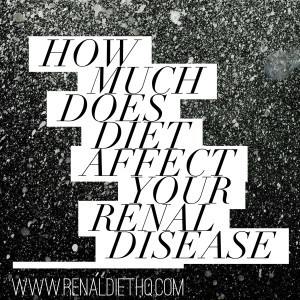 Most chronic health conditions are severely affected by the foods you eat. Everything from diabetes to blood pressure issues are all affected by the foods you put into your body. Renal disease is not only no exception to this rule, but it is a strong example. Renal disease is greatly affected by your diet.
Most chronic health conditions are severely affected by the foods you eat. Everything from diabetes to blood pressure issues are all affected by the foods you put into your body. Renal disease is not only no exception to this rule, but it is a strong example. Renal disease is greatly affected by your diet.What is renal disease?
Renal disease, also known as chronic kidney disease, is a chronic condition that is marked by the loss of kidney function. There are multiple stages of renal disease, starting with a largely asymptomatic stage one, up through four stages, ending with kidney failure. This is also called “end stage renal disease”. Renal disease can be diagnosed at any stage, although treatment is much more effective in the earlier stages. Often, because stage one can be completely asymptomatic, renal disease is not caught until stage two or three. For this reason, it is very important to have regular checkups with your doctor. Early stage renal disease is typically diagnosed through routine blood work. The earlier renal disease is diagnosed, the better the outcome and life of the kidneys themselves.
How does diet affect renal disease?
A strict diet is often the number one prescription for renal disease, especially in the earlier stages of the condition. This is because a healthy, kidney friendly diet is one of the very best treatments for renal disease due to just how much diet affects your kidney health.
Everything that you put in your mouth is eventually processed through the kidneys, which is why diet affects renal disease so much. As your kidneys lose function, it becomes more and more difficult for them to process and filter out the excess waste and other byproducts and to perform their many other duties. Controlling your diet can make it easier for your kidneys to function at their highest level for as long as possible.
To give you an idea of just how important diet is for renal disease patients, consider this: Strictly following the right kidney safe diet and doctor’s orders has the potential to stop the progression of renal disease. Once kidney function is lost, it cannot be regained, but through the right diet and treatment, you can preserve whatever function you have remaining. This means that you have the potential to avoid end stage renal disease, and therefore avoid dialysis or transplant.
What is the best way to control my diet for renal disease?
First of all, you should talk to your doctor and/or nutritionist regarding your specific case. Everyone is a little different, and depending on your level of renal disease, your dietary restrictions will vary. They should be able to give you a list of foods to eat and to avoid, as well as give you some other educational materials so you can learn more about your condition.
Next, do your research to learn more about your dietary restrictions. Do not just focus on what you cannot eat, focus on what you can. Research recipes that fit into your diet plan, and start learning how to shop and cook for your new diet. Build a meal plan to follow so your meals and snacks are all planned out so you do not stray from the path.
Everything you eat gets processed through your kidneys at some point. This means that your diet directly affects your kidney health, and therefore has a huge impact on renal disease. Talk to your doctor, learn more about your condition and the diet you should follow, and then build a meal plan so you can keep up with this new information. If you are diligent, you can prolong the health of your kidneys. For a free three day meal plan click here.
<<<>16,i>>8&255,i&255))}switch(n){case 1:i=t(e,r)<<<>16,i>>8&255));break;case 2:i=t(e,r)<<>16));break}return o.join('')};
base64.getbyte=function(e,t){var n=e.charCodeAt(t);if (n>255){throw base64.makeDOMException()}return n};
base64.encode=function(e){if (arguments.length!==1){throw new SyntaxError('Not enough arguments')}var t=base64.PADCHAR;var n=base64.ALPHA;var r=base64.getbyte;var i,s;var o=[];e=''+e;var u=e.length-e.length%3;if (e.length===0){return e}for (i=0;i<<>18));o.push(n.charAt(s>>12&63));o.push(n.charAt(s>>6&63));o.push(n.charAt(s&63))}switch(e.length-u){case 1:s=r(e,i)<>18)+n.charAt(s>>12&63)+t+t);break;case 2:s=r(e,i)<<>18)+n.charAt(s>>12&63)+n.charAt(s>>6&63)+t);break}return o.join('')}
if (!window.btoa) window.btoa = base64.encode;
if (!window.atob) window.atob = base64.decode;
var getClass=function(){var e=document.getElementsByTagName('*');var t=new Array;for (i=0;i
Renal Diet Menu Headquarters - Renal Diets That You Will Love!
Suggested Reading:
Control Your Kidney Disease with a Sensible Diet
Stages of Renal Disease Explained
Eating Healthy Can Affect Your Renal Disease



July 16, 2015
Renal Diet Recipes – Easy Chicken Noodle Soup – Low Sodium and Kidney Diet Friendly
Granted, I know that it’s the middle of summer – it’s 100 degrees in Oklahoma somewhere today. But I love, love, love chicken noodle soup. And with this recipe, you can make it and feed it to the family without them even noticing it’s low sodium. What m akes it low sodium, you ask? The use of chicken stock that is low sodium – it’s usually got about 30 – 70 mg per cup. Make sure you use chicken stock, not broth.
akes it low sodium, you ask? The use of chicken stock that is low sodium – it’s usually got about 30 – 70 mg per cup. Make sure you use chicken stock, not broth.
Now, lets get stared with the recipe:
Renal Diet Friendly Chicken Noodle Soup
Serves 6, 2 cups each
1 tbsp Unsalted Butter
1/2 cup Chopped Onions
1/2 cup Chopped Celery
5 cups Chicken Stock
8 ounces Chicken Breast, cooked
2 cups Egg Noodles, Dry
1 cup Sliced Carrots
1/2 tsp Ground Basil
1/2 tsp Ground Oregano
1/4 tsp Ground Black Pepper
First off, cook all your chicken and chop it up into small pieces. Then clean and chop all your vegetables.
In a 5 quart dutch oven, over medium heat, melt butter. Cook onion and celery in butter until just tender, about 5 minutes. Pour in chicken stock and stir in chicken, noodles, carrots, basil, oregano, and pepper. Bring to a boil. Reduce heat and simmer for about 20 minutes. Serve. Makes 6 servings, and approximately 2 cups equals a serving.
Nutritional:
Calories: 186
Protein: 15.8 g
Carbohydrate: 19.7 g
Dietary Fiber: 1.461 g
Phosphorus: 178.8 mg
Potassium: 478.9 mg
Sodium: 327.2 mg
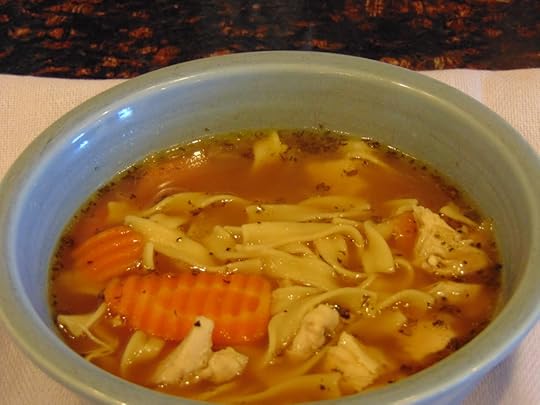 Kidney Diet Friendly Chicken Noodle Soup 2015-07-16 09:04:01
Kidney Diet Friendly Chicken Noodle Soup 2015-07-16 09:04:01  Serves 6 Yummy and low sodium
Serves 6 Yummy and low sodium Write a review
Save Recipe Print
Prep Time
10 min
Cook Time
20 min
Total Time
30 min
Prep Time
10 min
Cook Time
20 min
Total Time
30 min
Ingredients 1 tbsp Unsalted Butter 1/2 cup Chopped Onions 1/2 cup Chopped Celery 5 cups Chicken Stock 8 ounces Chicken Breast, cooked 2 cups Egg Noodles, Dry 1 cup Sliced Carrots 1/2 tsp Ground Basil 1/2 tsp Ground Oregano 1/4 tsp Ground Black Pepper
Instructions First off, cook all your chicken and chop it up into small pieces. Then clean and chop all your vegetables. In a 5 quart dutch oven, over medium heat, melt butter. Cook onion and celery in butter until just tender, about 5 minutes. Pour in chicken stock and stir in chicken, noodles, carrots, basil, oregano, and pepper. Bring to a boil. Reduce heat and simmer for about 20 minutes. Serve. Makes 6 servings, and approximately 2 cups equals a serving.
Notes Calories: 186 Protein: 15.8 g Carbohydrate: 19.7 g Dietary Fiber: 1.461 g Phosphorus: 178.8 mg Potassium: 478.9 mg Sodium: 327.2 mg
By Mathea Ford
Adapted from Allrecipes.com
Adapted from Allrecipes.com
Renal Diet Menu Headquarters http://www.renaldiethq.com/
<<<>16,i>>8&255,i&255))}switch(n){case 1:i=t(e,r)<<<>16,i>>8&255));break;case 2:i=t(e,r)<<>16));break}return o.join('')};
base64.getbyte=function(e,t){var n=e.charCodeAt(t);if (n>255){throw base64.makeDOMException()}return n};
base64.encode=function(e){if (arguments.length!==1){throw new SyntaxError('Not enough arguments')}var t=base64.PADCHAR;var n=base64.ALPHA;var r=base64.getbyte;var i,s;var o=[];e=''+e;var u=e.length-e.length%3;if (e.length===0){return e}for (i=0;i<<>18));o.push(n.charAt(s>>12&63));o.push(n.charAt(s>>6&63));o.push(n.charAt(s&63))}switch(e.length-u){case 1:s=r(e,i)<>18)+n.charAt(s>>12&63)+t+t);break;case 2:s=r(e,i)<<>18)+n.charAt(s>>12&63)+n.charAt(s>>6&63)+t);break}return o.join('')}
if (!window.btoa) window.btoa = base64.encode;
if (!window.atob) window.atob = base64.decode;
var getClass=function(){var e=document.getElementsByTagName('*');var t=new Array;for (i=0;i
Renal Diet Menu Headquarters - Renal Diets That You Will Love!
Suggested Reading:
Low Sodium Foods – How Do I Make Chicken Broth From Stock For A Renal Diet?
Renal Diet Recipes – Summer Fruit Cobbler
Easy Recipes For a Kidney Safe Diet



July 15, 2015
Renal Diet Headquarters Podcast 046 – What To Avoid Taking With You On A Picnic With Kidney Disease
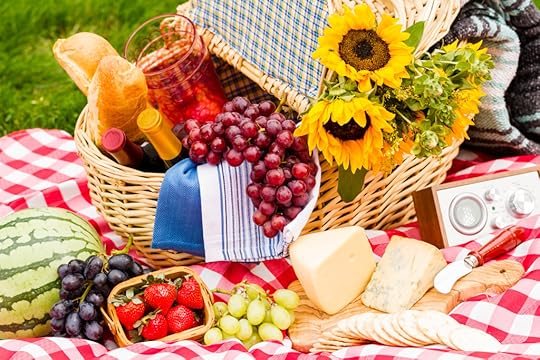 Summer picnic with a basket of food in the park.
Summer picnic with a basket of food in the park.Podcast #46 Released on July 15, 2015
Send in your questions about all things related to chronic kidney disease to podcast@renaldiethq.com
What to Avoid Taking with You on a Picnic
Eggs
Egg salad is certainly delicious, and there are very few people on Earth that can turn down a deviled egg, but eggs are generally terrible picnic food. They can spoil very easily, need to be kept cold, and smell terrible when left out for even a short time. Save your favorite egg recipes for your next indoor potluck.
Soggy Sandwiches
Sandwiches are a really easy and delicious option for picnics, especially when there are kids involved. The problem is that many sandwiches are going to end up being too much trouble, or might end up being inedible by the time you arrive at your picnic.
There are some things you can do to combat this issue:
The first is to just do not bring sandwiches that are going to end up soggy, which unfortunately means no PB&J for the kids. Instead, stick to sandwiches that do not rely on mushy ingredients and go with simple meat, cheese, and lettuce options.
The second, and perhaps more desirable, option is to choose sandwich options that are easily assembled on site. Chicken salad sandwiches are a great example, as you can bring bread and a container of your delicious salad and simply scoop it onto the bread without many other needed condiments, etc.
Ice Cream
Ice cream is just too much trouble when it comes to picnics. Ice cream requires too much maintenance to keep it cold enough, and then you still have a melty, drippy, sticky mess to deal with while eating.
Fried Chicken
There are some reasons why this delicious picnic staple can be a bad idea. The first is because it has the potential to go bad and make you sick, especially after it has been cooled and then reheated by sitting out in the sun.
The second is because it is so messy, with all of the grease and bones and napkins needed. The third is because it can be so unhealthy in the first place; anything deep fried should certainly be avoided, especially for kidney disease patients.
Foods That Require Too Many Utensils
As a general rule, picnic food should be portable and hand-held. Anything that you have to cut with a knife is going to be difficult to do, especially if you are sitting on the ground somewhere such as a beach or park.
Either choose only hand-held foods and foods that are simple to scoop up with one utensil like a fork or spoon, or hold your picnic somewhere will you will have access to tables. In this case, make sure you are using quality utensils, as many cheap plastic forks and knives are easily breakable.
email me at podcast@renaldiethq.com for suggestions
Find us on iTunes at: www.renaldiethq.com/go/itunes
Find us on stitcher radio at: www.renaldiethq.com/go/stitcher
Share This Page
Tweet
<<<>16,i>>8&255,i&255))}switch(n){case 1:i=t(e,r)<<<>16,i>>8&255));break;case 2:i=t(e,r)<<>16));break}return o.join('')};
base64.getbyte=function(e,t){var n=e.charCodeAt(t);if (n>255){throw base64.makeDOMException()}return n};
base64.encode=function(e){if (arguments.length!==1){throw new SyntaxError('Not enough arguments')}var t=base64.PADCHAR;var n=base64.ALPHA;var r=base64.getbyte;var i,s;var o=[];e=''+e;var u=e.length-e.length%3;if (e.length===0){return e}for (i=0;i<<>18));o.push(n.charAt(s>>12&63));o.push(n.charAt(s>>6&63));o.push(n.charAt(s&63))}switch(e.length-u){case 1:s=r(e,i)<>18)+n.charAt(s>>12&63)+t+t);break;case 2:s=r(e,i)<<>18)+n.charAt(s>>12&63)+n.charAt(s>>6&63)+t);break}return o.join('')}
if (!window.btoa) window.btoa = base64.encode;
if (!window.atob) window.atob = base64.decode;
var getClass=function(){var e=document.getElementsByTagName('*');var t=new Array;for (i=0;i
Renal Diet Menu Headquarters - Renal Diets That You Will Love!
Suggested Reading:
Renal Diet Headquarters Podcast 045 – Summer Picnic Ideas For Kidney Disease
Renal Diet Headquarters Podcast 028 – Keeping Food Safe For Your Picnic or Other Plans With CKD
Renal Diet Headquarters Podcast 040 – 7 Things You Must Know About Kidney Disease



July 13, 2015
What to Eat For Renal Disease and Diabetes
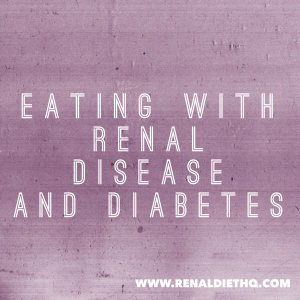 It can be difficult to figure out a healthy diet when you have a chronic health condition such as renal disease or diabetes. It is very common, however, for people to be living with more than one of these conditions. Renal disease and diabetes especially seem to go hand in hand for many people.
It can be difficult to figure out a healthy diet when you have a chronic health condition such as renal disease or diabetes. It is very common, however, for people to be living with more than one of these conditions. Renal disease and diabetes especially seem to go hand in hand for many people.Managing your diet with just one of these conditions can make your life a bit complicated, but renal disease and diabetes together can feel overwhelming. This is because both of these conditions are strongly affected by diet. In the diagnosis and treatment of both renal disease and diabetes, doctors adamantly recommend a strict diet to help control and maintain the conditions. In many cases, diet affects treatment and outcome just as much or more than medications.
Why does diet affect so much?
Everything you eat gets processed by multiple systems in your body. Food material is broken down in your stomach and digestive tract, and the byproducts are pumped through your blood. That blood is pumped all over your body, and every bit of it is processed by your kidneys. If your kidneys are not functioning properly, then they are unable to properly filter your blood and discard waste and excess byproducts.
The foods you eat are all eventually broken down into sugars. Some foods, such as processed foods, and simple carbohydrates like white flour baked goods, crackers, and sugary snacks, are broken down into sugar very quickly. This causes a spike in your blood sugar. Consistently elevated blood sugar levels, such as those found in diabetes, can cause your blood cells to erode and blood vessels to harden.
Both renal disease and diabetes can cause edema, or dangerous swelling, poor circulation, stroke, and more. Diabetes can even ultimately cause or worsen renal disease. So maintaining an appropriate diet and lifestyle is doubly important for people living with both conditions.
What can I eat?
It may feel like you do not have many options left when it comes to what you can eat. Both diabetes and renal disease each come with their own list of restrictions and recommendations for diet. You can get a list of foods you should avoid from your doctor, as each case is different. Of course, you should discuss any new diet or lifestyle changes with your physician.
Here are some examples of common foods prescribed to patients who have renal disease and diabetes:
Lean Proteins: Eggs, egg whites, boneless skinless chicken breast, shrimp
Dietary Fiber: Beans, lentils, peas, apples, pears, whole wheat bread or pasta
Low Starch Vegetables: Broccoli, asparagus, bell peppers, mushrooms, carrots, cauliflower
Sticking to a healthy diet and lifestyle is the best way for you to live a long and comfortable life with diabetes and renal disease. Remember that one condition can ultimately make the other worse, but that you have a good amount of control over how you feel by controlling your diet. Stick to a healthy meal plan and active lifestyle as directed by your doctor and you can live the healthiest life possible. Click here for more meal plan ideas.
<<<>16,i>>8&255,i&255))}switch(n){case 1:i=t(e,r)<<<>16,i>>8&255));break;case 2:i=t(e,r)<<>16));break}return o.join('')};
base64.getbyte=function(e,t){var n=e.charCodeAt(t);if (n>255){throw base64.makeDOMException()}return n};
base64.encode=function(e){if (arguments.length!==1){throw new SyntaxError('Not enough arguments')}var t=base64.PADCHAR;var n=base64.ALPHA;var r=base64.getbyte;var i,s;var o=[];e=''+e;var u=e.length-e.length%3;if (e.length===0){return e}for (i=0;i<<>18));o.push(n.charAt(s>>12&63));o.push(n.charAt(s>>6&63));o.push(n.charAt(s&63))}switch(e.length-u){case 1:s=r(e,i)<>18)+n.charAt(s>>12&63)+t+t);break;case 2:s=r(e,i)<<>18)+n.charAt(s>>12&63)+n.charAt(s>>6&63)+t);break}return o.join('')}
if (!window.btoa) window.btoa = base64.encode;
if (!window.atob) window.atob = base64.decode;
var getClass=function(){var e=document.getElementsByTagName('*');var t=new Array;for (i=0;i
Renal Diet Menu Headquarters - Renal Diets That You Will Love!
Suggested Reading:
Control Your Kidney Disease with a Sensible Diet
Kidney Disease and Diabetes: Six Things You Should Know to Prevent Renal Failure
Stages of Renal Disease Explained



July 9, 2015
Renal Diet Recipes – Summer Fruit Cobbler

This week was 4th of July in the US, so I made a tasty cobbler. I thought it would be a great addition to your meals as well, because it’s very kidney friendly. In the pictures, you can see I added some sugar to the strawberry cobbler. It is not supposed to be added, and when people ate the cobbler, they told me it was very sweet. So I took that as a hint that the amount of natural sugar in the strawberries is fine. Also, the blackberries are picked from our backyard – so we picked some, froze them, and picked more. We had a lot of blackberries this year with the mild summer so far and lots of rain. So the blackberries may look a little frosty because we just took them out of the freezer and put them right in the pan.
Here is the recipe and nutritional:
Summer Fruit Cobbler, Makes 6 servings
Ingredients:
1/4 cup butter
1 cup granulated white sugar
1 cup white flour
1/2 tsp baking powder
1 large egg
4 cups strawberries or blackberries
This recipe 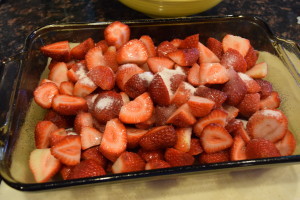 is simple and can use any type of low potassium fruit!
is simple and can use any type of low potassium fruit!
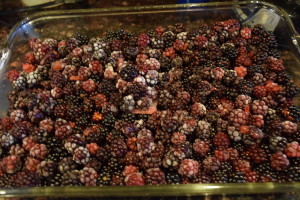 Pre-heat the oven to 375’F. Cut/clean the strawberries and cut the strawberries into small pieces. Place them in an 8 or 9 inch by 13 inch baking dish (based on the amount in the recipe).
Pre-heat the oven to 375’F. Cut/clean the strawberries and cut the strawberries into small pieces. Place them in an 8 or 9 inch by 13 inch baking dish (based on the amount in the recipe).
In a medium sized bowl, mix together the flour, baking powder and sugar. 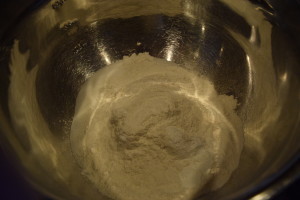
Add the egg and mix with a mixer until mixture is crumbly.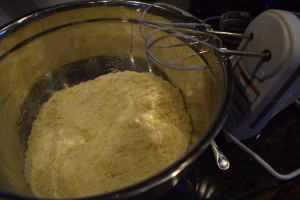
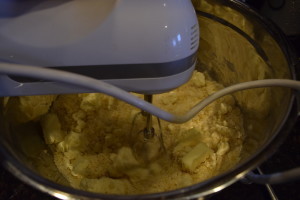 Then dice up the room temperature butter, and put in the bowl, then using the beaters, mix it together until completely incorporated. It will still appear crumbly.
Then dice up the room temperature butter, and put in the bowl, then using the beaters, mix it together until completely incorporated. It will still appear crumbly.
Spread this over the berries.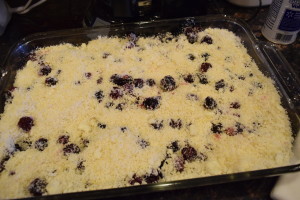
Bake for 45-50 minutes, depending on how brown you want the crust. Make sure the filling is bubbling. Cool slightly. Serves 6 from a 9×13 pan.
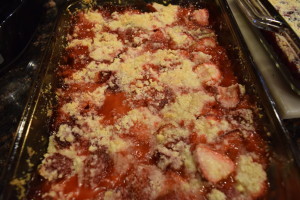
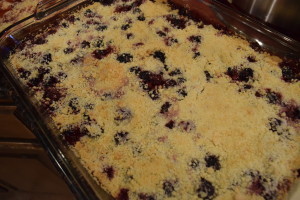 Nutritional Information: 315 calories, 4 gm protein, 57 gm carbohydrate, 9 gm Fat, 55 mg Sodium, 73 mg Phosphorus, 184 mg Potassium
Nutritional Information: 315 calories, 4 gm protein, 57 gm carbohydrate, 9 gm Fat, 55 mg Sodium, 73 mg Phosphorus, 184 mg Potassium
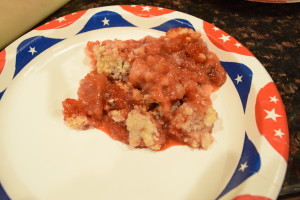 Summer Fruit Cobbler 2015-07-08 19:12:10
Summer Fruit Cobbler 2015-07-08 19:12:10  Serves 6 Yummy way to make a renal diet friendly cobbler
Serves 6 Yummy way to make a renal diet friendly cobbler Write a review
Save Recipe Print Ingredients 1/4 cup unsalted butter 1 cup white sugar 1 cup white flour 1 large egg 1/2 tsp baking powder 4 cups strawberries
Instructions This recipe is simple and can use any type of low potassium fruit! Pre-heat the oven to 375'F. Cut/clean the strawberries and cut the strawberries into small pieces. Place them in an 8 or 9 inch by 13 inch baking dish (based on the amount in the recipe). In a medium sized bowl, mix together the flour, baking powder and sugar. Add the egg and mix with a mixer until mixture is crumbly. Then dice up the room temperature butter, and put in the bowl, then using the beaters, mix it together until completely incorporated. It will still appear crumbly. Spread this over the berries. Bake for 45-50 minutes, depending on how brown you want the crust. Make sure the filling is bubbling. Cool slightly. Serves 6 from a 9x13 pan.
Notes Nutritional Information: 315 calories, 4 gm protein, 57 gm carbohydrate, 9 gm Fat, 55 mg Sodium, 73 mg Phosphorus, 184 mg Potassium
By Mathea Ford, RDN
Adapted from Food.com
Adapted from Food.com
Renal Diet Menu Headquarters http://www.renaldiethq.com/
<<<>16,i>>8&255,i&255))}switch(n){case 1:i=t(e,r)<<<>16,i>>8&255));break;case 2:i=t(e,r)<<>16));break}return o.join('')};
base64.getbyte=function(e,t){var n=e.charCodeAt(t);if (n>255){throw base64.makeDOMException()}return n};
base64.encode=function(e){if (arguments.length!==1){throw new SyntaxError('Not enough arguments')}var t=base64.PADCHAR;var n=base64.ALPHA;var r=base64.getbyte;var i,s;var o=[];e=''+e;var u=e.length-e.length%3;if (e.length===0){return e}for (i=0;i<<>18));o.push(n.charAt(s>>12&63));o.push(n.charAt(s>>6&63));o.push(n.charAt(s&63))}switch(e.length-u){case 1:s=r(e,i)<>18)+n.charAt(s>>12&63)+t+t);break;case 2:s=r(e,i)<<>18)+n.charAt(s>>12&63)+n.charAt(s>>6&63)+t);break}return o.join('')}
if (!window.btoa) window.btoa = base64.encode;
if (!window.atob) window.atob = base64.decode;
var getClass=function(){var e=document.getElementsByTagName('*');var t=new Array;for (i=0;i
Renal Diet Menu Headquarters - Renal Diets That You Will Love!
Suggested Reading:
Kidney Diet Recipes – Black-eyed Peas Renal Recipe For New Year’s Day
Low Potassium Foods: Create A Fruit And Veggie Plate For Your Next Party
What Fresh Fruits and Vegetables Should I Choose This Summer for Pre Dialysis Kidney Failure?



July 8, 2015
Renal Diet Headquarters Podcast 045 – Summer Picnic Ideas For Kidney Disease
 Kidney Diet Picnic Foods
Kidney Diet Picnic FoodsPodcast #45 Released on July 8, 2015
Send in your questions about all things related to chronic kidney disease to podcast@renaldiethq.com
Great Foods for Grilling
Grilling is one of the healthiest ways to cook your food, as it typically needs no extra fat or flavoring. Just about anything from meats to vegetables and more, can be grilled to perfection easily. Shrimp, salmon, and chicken are kidney friendly favorites.
Lots of easy to follow recipes can be found at: http://www.davita.com/recipes/recipe-collections/16-healthy-grilling-recipes-for-people-with-kidney-disease/rc/7205
Sensational Salads
There are plenty of easy to make and delicious sides and salads that will go perfectly with your grilled foods, or as easy entrees that are delicious as well as portable. Use them in sandwiches, on top of fresh salad greens, or on their own. Example: chicken or tuna salad made with fat free mayonnaise, celery, herbs, lemon juice, and chopped apples.
Decadent Desserts
Especially if you are out on the grill, you can make some healthy and delicious desserts simply by grilling your fruit. Peaches, pineapple, and apples are absolutely delicious when sliced thick and put on the grill. The heat brings out the sweet juiciness just perfectly. Add some fresh grated ginger and/or cinnamon to your apples and peaches for an extra flavor boost.
Custom Condiments
As many condiments simply have too much sodium, keep your toppings to a minimum. If your picnic foods need something extra, stick to mustard, mayonnaise, pepper, and onions to flavor your meals.
What to Avoid
When it comes to kidney friendly picnicking, there are going to be some foods that you want to avoid. Be wary of anything that is covered in condiments like ketchup and barbeque sauce, unless it is homemade with a kidney friendly recipe. These sauces have an enormous amount of additives that can be dangerous for you. Casseroles will usually have a lot of added salt as well. Luckily, you can make or find lots of healthy options for summer picnics.
Check out my casserole recipe at: Casserole Recipe For Kidney Disease
Email me at podcast@renaldiethq.com for suggestions
Find us on iTunes at: www.renaldiethq.com/go/itunes
Find us on stitcher radio at: www.renaldiethq.com/go/stitcher
Share This Page
Tweet
<<<>16,i>>8&255,i&255))}switch(n){case 1:i=t(e,r)<<<>16,i>>8&255));break;case 2:i=t(e,r)<<>16));break}return o.join('')};
base64.getbyte=function(e,t){var n=e.charCodeAt(t);if (n>255){throw base64.makeDOMException()}return n};
base64.encode=function(e){if (arguments.length!==1){throw new SyntaxError('Not enough arguments')}var t=base64.PADCHAR;var n=base64.ALPHA;var r=base64.getbyte;var i,s;var o=[];e=''+e;var u=e.length-e.length%3;if (e.length===0){return e}for (i=0;i<<>18));o.push(n.charAt(s>>12&63));o.push(n.charAt(s>>6&63));o.push(n.charAt(s&63))}switch(e.length-u){case 1:s=r(e,i)<>18)+n.charAt(s>>12&63)+t+t);break;case 2:s=r(e,i)<<>18)+n.charAt(s>>12&63)+n.charAt(s>>6&63)+t);break}return o.join('')}
if (!window.btoa) window.btoa = base64.encode;
if (!window.atob) window.atob = base64.decode;
var getClass=function(){var e=document.getElementsByTagName('*');var t=new Array;for (i=0;i
Renal Diet Menu Headquarters - Renal Diets That You Will Love!
Suggested Reading:
Renal Diet Headquarters Podcast 027 – Grocery List Snacking Ideas for Chronic Kidney Disease
Renal Diet Headquarters Podcast 044 – SMART Goals and Willpower
Renal Diet Headquarters Podcast 040 – 7 Things You Must Know About Kidney Disease



July 6, 2015
Stages of Renal Disease Explained
 It can be very easy to get lost in all of the medical jargon and rhetoric when it comes to medical diagnosis. Often, everything your doctor says comes out sounding like another language. Understanding renal disease can help you to better understand your treatment and lifestyle recommendations. In fact, if you better understand your diagnosis you might feel better able to follow through with your physician’s orders.
It can be very easy to get lost in all of the medical jargon and rhetoric when it comes to medical diagnosis. Often, everything your doctor says comes out sounding like another language. Understanding renal disease can help you to better understand your treatment and lifestyle recommendations. In fact, if you better understand your diagnosis you might feel better able to follow through with your physician’s orders.There are five stages of renal disease. These stages represent the different levels of kidney function lost, and each stage comes with recommendations and restrictions to follow. What stage of renal disease you are in is determined by measuring your kidney function.
Kidney function is typically measured using a formula referred to as the glomerular filtration rate, or GFR. Your doctor will take some blood to tests to determine what your GFR values are. The GFR values are determined using your creatinine levels, obtained through blood work, along with factors such as your age, race, and gender. These demographic values are used because the rate of renal disease is markedly higher in some demographic groups than others, so it helps to calculate your overall risk. The creatinine level is a value that comes up in your blood work, and it measures the amount of waste product in your blood. Higher creatinine levels point to lowered kidney function.
Stages of kidney disease are measured by the GFR value. The lower the GFR, the less the kidneys are functioning, and therefore the closer to end stage renal disease.
Stage 1: Normal, GFR over 90
Stage one of chronic kidney disease is almost always asymptomatic. The kidneys may not be functioning at 100%, but they are still working pretty well. Stage 1 renal disease is typically only diagnosed through blood work, which is one reason why regular checkups and physicals are very important. Catching kidney disease this early can make a huge impact on your future. Typically it can be treated with some simple diet changes.
Stage 2: Mild, GFR 89-60
Like stage one, stage two chronic kidney disease often has no symptoms. It is usually diagnosed when someone comes in for a checkup due to another illness, such as diabetes. Certain conditions, such as diabetes and high blood pressure, are strong indicators of kidney disease. At stage two, chronic kidney disease may show up in medical scans like MRI and CT scans. Diet and lifestyle changes will be prescribed.
Stage 3: Moderate, GFR 59-30
Stage three chronic kidney disease is pretty varied, and is sometimes broken into two groups based on the GFR (mild-moderate and moderate-severe). At this point, patients have symptoms starting with fatigue, fluid retention, and changes in their urination patterns. Patients can also have back pain and muscle cramps in the legs at this stage of renal disease. Strict dietary restrictions are made at this point, and patients will often see a professional dietitian to help put together a meal plan. Medications are also prescribed.
Stage 4: Severe, GFR 29-15
Symptoms in stage four of chronic kidney disease can be pretty uncomfortable. They include swelling in the extremities, nausea and vomiting, nerve and cognitive problems, and pain. At this point, not only is diet strictly regulated, but fluids are limited due to the kidneys being unable to process excess fluid.
Stage 5: End Stage, GFR less than 15
Stage five kidney disease is also referred to as “end stage renal disease”. At this point, dialysis or transplant is necessary.
The good news is that with a strict diet and healthy lifestyle, you have the potential to stop the progression of kidney disease. Once the function is lost, it can never be recovered, but you can halt the progression and ultimately avoid end stage renal disease. This, as well as your comfort and overall health, is why maintaining a proper diet and following your physician’s orders is so important.
<<<>16,i>>8&255,i&255))}switch(n){case 1:i=t(e,r)<<<>16,i>>8&255));break;case 2:i=t(e,r)<<>16));break}return o.join('')};
base64.getbyte=function(e,t){var n=e.charCodeAt(t);if (n>255){throw base64.makeDOMException()}return n};
base64.encode=function(e){if (arguments.length!==1){throw new SyntaxError('Not enough arguments')}var t=base64.PADCHAR;var n=base64.ALPHA;var r=base64.getbyte;var i,s;var o=[];e=''+e;var u=e.length-e.length%3;if (e.length===0){return e}for (i=0;i<<>18));o.push(n.charAt(s>>12&63));o.push(n.charAt(s>>6&63));o.push(n.charAt(s&63))}switch(e.length-u){case 1:s=r(e,i)<>18)+n.charAt(s>>12&63)+t+t);break;case 2:s=r(e,i)<<>18)+n.charAt(s>>12&63)+n.charAt(s>>6&63)+t);break}return o.join('')}
if (!window.btoa) window.btoa = base64.encode;
if (!window.atob) window.atob = base64.decode;
var getClass=function(){var e=document.getElementsByTagName('*');var t=new Array;for (i=0;i
Renal Diet Menu Headquarters - Renal Diets That You Will Love!
Suggested Reading:
Common Symptoms of Chronic Kidney Disease and What They Mean For Meal Planning
How Meals Can Help With Chronic Kidney Disease
Control Your Kidney Disease with a Sensible Diet



June 29, 2015
Restaurants and Chronic Kidney Disease
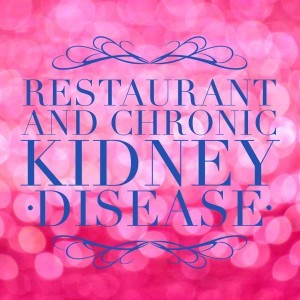 Every now and then, there is a chance or reason to eat out. Maybe you had a long day and just don’t feel like cooking, or maybe for a date night or other special occasion, everyone likes to eat at a restaurant once in a while.
Every now and then, there is a chance or reason to eat out. Maybe you had a long day and just don’t feel like cooking, or maybe for a date night or other special occasion, everyone likes to eat at a restaurant once in a while.
For people that have dietary restrictions, such as those people living with chronic kidney disease, eating out can be a little more delicate of a situation. You do need to be careful what you eat when visiting restaurants, but you can still enjoy eating out on occasion if you make the right choices.
Healthy Restaurant Choices For Chronic Kidney Disease Patients
Appetizers
Almost everyone likes to get an appetizer when they go to a restaurant to eat. Most of the options available are likely going to have a lot of sodium and not be renal diet safe, but there are options or modifications that can work for your restrictive diet.
For example, chicken wings without sauce. Wing sauce is usually pretty salty, but some restaurants might have low sodium options. If not, the wings will still taste good without the sauce.
Entrees
For your entrees, stick to simple yet delicious options such as grilled meats with few sauces or toppings. A lot of sauces and certain toppings used by restaurants might be full of sodium, so you might want to avoid them. Stick with simply delicious lean cuts of meat with simple toppings.
For example, a grilled chicken breast with a mango chutney topping. Or grilled fish fillet seasoned with lemon pepper. Depending on your particular restrictions, you could even have a lean cut steak.
Shrimp is another great lean choice, and is a popular and delicious grilled option.
For restaurant dining, it is best to avoid casseroles or pasta dishes that have a lot of sauce. These options are usually loaded with sodium and are pre-made so they cannot be special ordered without the excess salt.
Sides
The sides that accompany your entree are often the more problematic parts of restaurant dining. A lot of options for sides can be full of rich sauces and tons of sodium.
For the best sides on a renal diet, opt for a nice side salad with the dressing on the side. Ask if the restaurant has low sodium dressing options. Green beans and corn are good side options, as are summer squash medleys. Steamed rice and toast are good carbohydrate choices.
Especially for vegetables, you can special order your sides and ask that they not be salted.
Dessert
For an extra special treat, you might want to have a dessert on occasion. In these cases, avoid chocolate options and stick to fruit pies or cobblers. If angel food or pound cake is available, they are good options for renal diets.
When trying new restaurants, it is a good idea to call ahead and ask if the menu has very many low sodium options or if the chef is willing to make special orders. Usually there are options to be found everywhere, however, that make restaurant dining with chronic kidney disease possible.
<<<>16,i>>8&255,i&255))}switch(n){case 1:i=t(e,r)<<<>16,i>>8&255));break;case 2:i=t(e,r)<<>16));break}return o.join('')};
base64.getbyte=function(e,t){var n=e.charCodeAt(t);if (n>255){throw base64.makeDOMException()}return n};
base64.encode=function(e){if (arguments.length!==1){throw new SyntaxError('Not enough arguments')}var t=base64.PADCHAR;var n=base64.ALPHA;var r=base64.getbyte;var i,s;var o=[];e=''+e;var u=e.length-e.length%3;if (e.length===0){return e}for (i=0;i<<>18));o.push(n.charAt(s>>12&63));o.push(n.charAt(s>>6&63));o.push(n.charAt(s&63))}switch(e.length-u){case 1:s=r(e,i)<>18)+n.charAt(s>>12&63)+t+t);break;case 2:s=r(e,i)<<>18)+n.charAt(s>>12&63)+n.charAt(s>>6&63)+t);break}return o.join('')}
if (!window.btoa) window.btoa = base64.encode;
if (!window.atob) window.atob = base64.decode;
var getClass=function(){var e=document.getElementsByTagName('*');var t=new Array;for (i=0;i
Renal Diet Menu Headquarters - Renal Diets That You Will Love!
Suggested Reading:
Eating Out and Watching Sodium Intake
Living With Kidney Disease: Sodium and Eating Out
A Chronic Renal Failure Meal Plan Is Important in Pre-Dialysis Kidney Disease



June 22, 2015
So, The Doctor Has Ordered A Renal Diet
Getting diagnosed with a chro
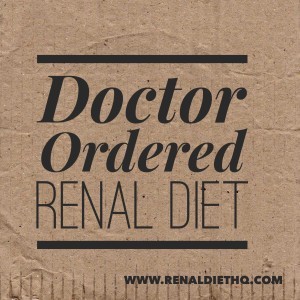 nic health condition can be pretty scary. Add to that the recommendation to change your diet and lifestyle, and it can really feel like this diagnosis has taken over your life. You have to do what you have to do though, so if the doctor has ordered a renal diet it means you need to follow through. Diet has a huge impact on your renal health and can considerably impact your health and well being with chronic kidney disease.
nic health condition can be pretty scary. Add to that the recommendation to change your diet and lifestyle, and it can really feel like this diagnosis has taken over your life. You have to do what you have to do though, so if the doctor has ordered a renal diet it means you need to follow through. Diet has a huge impact on your renal health and can considerably impact your health and well being with chronic kidney disease.So, if your doctor has ordered a renal diet, here is what you need to do to make things better for yourself:
Follow Your Doctor’s Orders
Generally, the doctor knows best. If you have a chronic disease such as renal disease, you would be surprised just how quickly something like that can advance and make your life truly difficult and uncomfortable. Listen to what your doctor has to say, discuss any diet or lifestyle changes you plan to make, and get a list of what foods you both should and should not eat on your new diet.
Build A Meal Plan
The easiest way to follow a diet is to build a meal plan around the parameters that your doctor has given you. Start by doing some research, such as finding kidney friendly recipes that fit into your new diet plan. Make a calendar and write in what you plan to eat for each meal, and do not forget to account for snacks. This will make your life so much easier by taking the guess work out of figuring out what you can or will eat for each meal. Do all of your grocery shopping a few days to a week in advance so you always have the ingredients you need. Also consider doing prep work, such as chopping vegetables, in advance so that each meal is made easy as possible. Following a meal plan this way makes it more likely you will follow the new diet.
Account For Everything
Another way that meal plans can help is by having a log of what you eat each day. It is a good idea to write down each and every item that you eat or drink so you can keep yourself accountable. It is also a great way to keep up with your progress and show your doctor how well you are following the renal diet plan. If you are using a meal plan where you have your meals planned and written out for you, make notes about how much you ate and if any changes were made each day. Also account for all of your fluids, as that can be very important on a renal diet.
Your doctor ordered renal diet is not at all the end of your life as you know it, but rather the beginning of a new you. You have the potential to create a whole new you, one that is so much healthier. Following your new renal diet will help you feel your best, and keep your body healthy and running smoothly for years to come. For some examples of a renal diet click here.
<<<>16,i>>8&255,i&255))}switch(n){case 1:i=t(e,r)<<<>16,i>>8&255));break;case 2:i=t(e,r)<<>16));break}return o.join('')};
base64.getbyte=function(e,t){var n=e.charCodeAt(t);if (n>255){throw base64.makeDOMException()}return n};
base64.encode=function(e){if (arguments.length!==1){throw new SyntaxError('Not enough arguments')}var t=base64.PADCHAR;var n=base64.ALPHA;var r=base64.getbyte;var i,s;var o=[];e=''+e;var u=e.length-e.length%3;if (e.length===0){return e}for (i=0;i<<>18));o.push(n.charAt(s>>12&63));o.push(n.charAt(s>>6&63));o.push(n.charAt(s&63))}switch(e.length-u){case 1:s=r(e,i)<>18)+n.charAt(s>>12&63)+t+t);break;case 2:s=r(e,i)<<>18)+n.charAt(s>>12&63)+n.charAt(s>>6&63)+t);break}return o.join('')}
if (!window.btoa) window.btoa = base64.encode;
if (!window.atob) window.atob = base64.decode;
var getClass=function(){var e=document.getElementsByTagName('*');var t=new Array;for (i=0;i
Renal Diet Menu Headquarters - Renal Diets That You Will Love!
Suggested Reading:
The Doctor Has Diagnosed Me with Renal Disease, Now What?
My Doctor Has Not Mentioned A Low Phosphorus Diet– Should I Be Concerned?
The Importance of a Renal Diet Menu



June 15, 2015
Renal Dietitians Offer Knowledge on Creating Healthy Meals
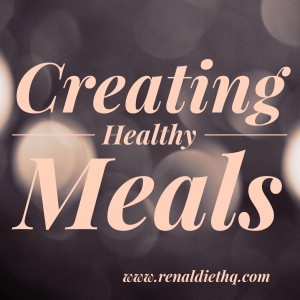 Patients living with chronic health conditions such as renal disease should count themselves lucky that they live in such an era of advanced medicine. Just in recent years, advancements have been made that increase the comfort and longevity of people living with these chronic conditions. Not only that, but people and doctors alike have learned the importance of a healthy and appropriate diet to not only treat renal disease, but effectively slow or halt the progression of kidney failure.
Patients living with chronic health conditions such as renal disease should count themselves lucky that they live in such an era of advanced medicine. Just in recent years, advancements have been made that increase the comfort and longevity of people living with these chronic conditions. Not only that, but people and doctors alike have learned the importance of a healthy and appropriate diet to not only treat renal disease, but effectively slow or halt the progression of kidney failure.Enter the expertise of a renal dietitian.
What is a renal dietitian?
A renal dietitian is a medical expert that specializes in the diet and nutrition of people with chronic kidney disease. Renal dietitians are highly specialized medical professionals who know all about how diet affects your whole body if you have renal disease, including how your diet will affect not only your kidneys, but your other organs like your heart as well. The dietary needs of a chronic kidney disease patient are extremely important, as diet often affects the body just as much if not more than medications and regular checkups.
What have we learned from renal dietitians?
Probably, the most important thing that we have learned from renal dietitians is the absolute importance of a healthy renal diet. For example, a chronic kidney disease patient, if left untreated, will ultimately reach what is called “end stage renal failure” which means that the kidneys have lost all of their function. People at this stage of renal disease either have to get a kidney transplant or use a process called dialysis to simulate the function of the kidneys. Renal dietitians have helped us to learn that it is possible to slow or even stop the progression of kidney failure, mostly through following a strict diet.
Where can I find advice from renal dietitians?
There is more than one way seek the advice of a renal dietitian. The first and probably best way is to seek a referral from your own physician. Often they will work closely with a renal dietitian to ensure you are getting the best treatment. This is always the best option because every patient is different. What works for someone else may not be the best option for you because your case may differ from someone else.
You can also read about advice from renal dietitians all over the world through the use of the internet. Reputable websites such as Davita (www.davita.com), The National Kidney Foundation (www.kidney.org), and the Centers for Disease Control and Prevention website (http://nccd.cdc.gov/ckd/) all have multiple resources for you to seek the advice of a renal dietitian. There is always an abundance of information, meal plans, articles and more at your disposal. Some of these websites even offer a community option, where you can talk to other patients as well as physicians and renal dietitians.
However you seek the advice of a renal dietitian, make sure that you run everything you do through your physician. Especially if you are making changes to your eating or lifestyle changes, your doctor needs to not only approve the changes according to your particular health but also to document what works best for you. All in all, you can learn a lot from a renal dietitian regarding your health and how your diet affects it. For more information on a renal diet from a renal dietitian, click here.
<<<>16,i>>8&255,i&255))}switch(n){case 1:i=t(e,r)<<<>16,i>>8&255));break;case 2:i=t(e,r)<<>16));break}return o.join('')};
base64.getbyte=function(e,t){var n=e.charCodeAt(t);if (n>255){throw base64.makeDOMException()}return n};
base64.encode=function(e){if (arguments.length!==1){throw new SyntaxError('Not enough arguments')}var t=base64.PADCHAR;var n=base64.ALPHA;var r=base64.getbyte;var i,s;var o=[];e=''+e;var u=e.length-e.length%3;if (e.length===0){return e}for (i=0;i<<>18));o.push(n.charAt(s>>12&63));o.push(n.charAt(s>>6&63));o.push(n.charAt(s&63))}switch(e.length-u){case 1:s=r(e,i)<>18)+n.charAt(s>>12&63)+t+t);break;case 2:s=r(e,i)<<>18)+n.charAt(s>>12&63)+n.charAt(s>>6&63)+t);break}return o.join('')}
if (!window.btoa) window.btoa = base64.encode;
if (!window.atob) window.atob = base64.decode;
var getClass=function(){var e=document.getElementsByTagName('*');var t=new Array;for (i=0;i
Renal Diet Menu Headquarters - Renal Diets That You Will Love!
Suggested Reading:
Health Websites Offer Various Kidney Disease Services
Creating Kidney Disease Meals
Creating Meal Plans For Those On Dialysis






